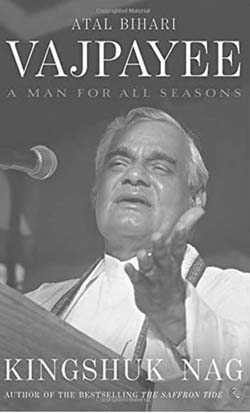In the year 1996 during an election rally in Lucknow when Atal Bihari Vajpayee stepped on the stage the excited crowd chanted, ‘Hamara PM kaisa ho, Atal Bihari Jaisa ho’. Vajpayee retorted in his characteristic style, ‘Arre PM chodo, pahle MP to banao’. What followed was another round of applause and cheers. Such rallies became Vajpayee’s trademark where he used wit and humour to strike a chord with his listeners instead of empty promises.
In his sixties, Vajpayee had a huge following of youngsters who had been brought up in Uttar Pradesh and other States of the Hindi heartland of 1990s and had grown up listening to his poems and anecdotes. He could play with words in poetry as well as prose. He used more than just words—body, gestures, eyes, even pauses—to express himself. A number of times his pauses were more potent than his words. This gift went a long way in his journey as a respected parliamentarian and later the Prime Minister of the country.
Atal Bihari Vajpayee: A Man for All Seasons is a first concerted attempt in English language to chronologically document the life and times of Atal Bihari Vajpayee. The author Kingshuk Nag has been a journalist for the last 22 years with a prestigious national newspaper. Currently, in an editorial position, Nag had covered events in Gujarat and elsewhere during his role as a political reporter and written books on Prime Minister Narendra Modi as well as the Bhartiya Janata Party.
Nag met several senior politicians, bureaucrats and journalists to bring out the little known facts about Vajpayee. While this book is more journalistic in nature, it provides a unique insight into the political and personal life of Vajpayee. For example, not many would know that Vajpayee had supported the candidature of Jagjivan Ram as the Prime Minister in the year 1980. An offer was also made to Vajpayee and others to join the Janata Dal with the leaders suggesting that he will feel more liberated in the new party which was claimed to be closer to the ideas of Jai Prakash Narayan and Gandhi as compared to the BJP.
This book also offers a chapter that reveals details of Vajpayee’s personal life that have so far stayed out of public view. However, Nag does not allow this part to overwhelm him. It was a proof of Atal’s statesmanship that he never hid his association with a lady named Mrs Kaul and was never questioned about it either by the media or by his fellow politicians—both friends and foes. Nag sticks to facts in this regard and takes care not to impose words on one of the most inconspicuous yet important equations in the life of Vajpayee.
The book also takes head on the controversy aboutVajpayee being a freedom fighter. Nag chronicles the events that took place when Vajpayee participated in the Satyagraha of 1942 in his native place in Bateshwar near Agra.

